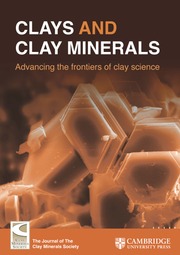Article contents
Crystallographic site distribution and redox activity of Fe in nontronites determined by optical spectroscopy
Published online by Cambridge University Press: 01 January 2024
Abstract
Optical absorption spectroscopy has the potential to uncover many characteristics of Fe-bearing, redox-active smectites that have heretofore been hidden. The purpose of this study was to exploit this technique to reveal the temperature dependence of the spectra and to characterize the behavior of octahedral and tetrahedral Fe(III) under various stages of reduction. The Uley nontronites, NAu-1 and NAu-2, were compared using optical spectroscopy, which probed the crystallographic-site distribution of Fe in the clay structures as well as the resulting differences in the reduction process in the two minerals. All of the major differences in the spectra of the two minerals in the wavelength range 450–950 nm are due to the presence of a significant amount of tetrahedral Fe(III) in NAu-2. In situ observation of the optical spectra of NAu-1 suspensions as a function of the degree of reduction reveals a steady increase in the dominant intervalence charge transfer (IVCT) band and the resulting blue-green color as the Fe(II) content of the octahedral sheet increases. Although the spectrum of NAu-2 at ∼50% reduction looks nearly identical to the spectrum of NAu-1 at a similar state of reduction, the spectra corresponding to the initial stages of reduction are quite different. Stepwise reduction of NAu-2 causes a rapid decrease in the absorbance features due to crystal-field transitions of tetrahedral Fe(III) before the IVCT band appears, suggesting that tetrahedral Fe(III) is preferentially reduced before the octahedral Fe(III). The intensity of the absorbance features due to tetrahedral Fe(III) also exhibit an inverse temperature dependence, suggesting that they are enhanced due to exchange-coupling with Fe(III) ions in neighboring sites. Spectra of NAu-1 at liquid nitrogen temperature, therefore, allowed the identification of a small amount of tetrahedral Fe(III) in NAu-1 that had not been noted previously.
Information
- Type
- Article
- Information
- Copyright
- © The Clay Minerals Society 2009
References
- 15
- Cited by

